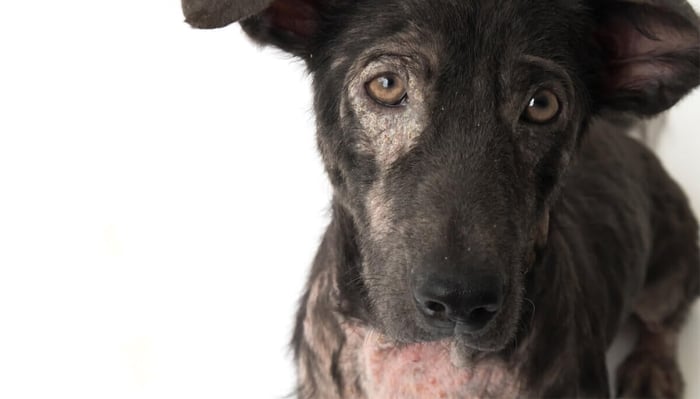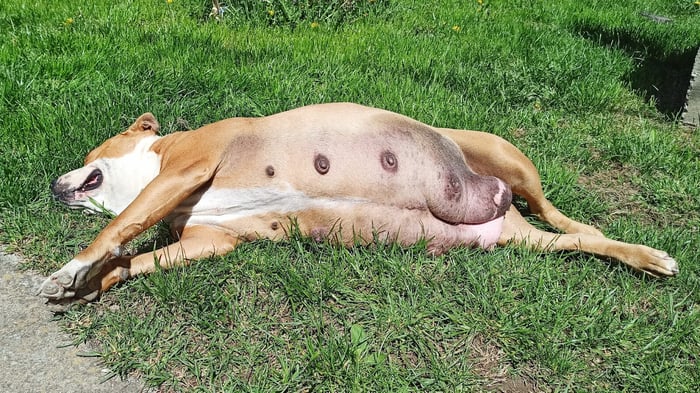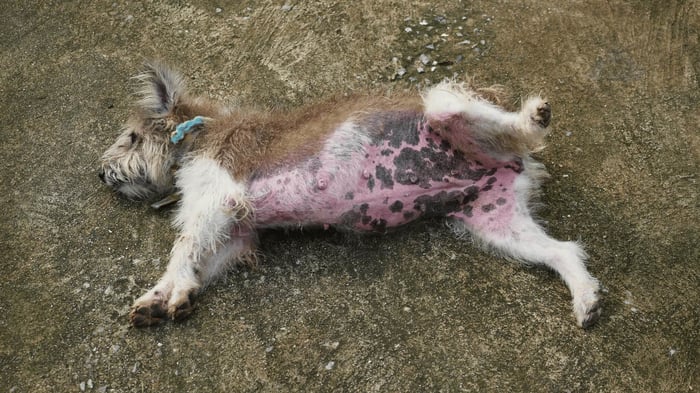It’s common for dogs to get a scab now and then, but if you keep finding black scabs on your dog with no obvious explanation, it may be a sign that something is wrong.
You may find scabs clustered in certain places, such as the ears, the belly, or the back. Sometimes dark scabs come with other symptoms, such as balding hair loss, bad smells, or pus.
So what causes black scabs on dogs? Are they harmless, or could they signal a much greater problem?
What Does It Mean If My Dog Has Black Scabs?
For a healthy dog with no underlying condition, a black scab signifies that the scab is old and almost ready to fall off. When the skin is damaged, blood rushes to the area, and the blood platelets clot, turning dark from oxidation.
They form a dry crust to protect the wound from dirt and pathogens. As the scab ages, the iron in the hemoglobin oxidizes and turns into methemoglobin and then hemichrom. At this stage, the crusty scab turns black and should usually fall off soon, so long as the tissue beneath is healing as it should.
However, black scabs on a dog can mean far more than a nearly healed injury. So let’s look at the primary causes of black crusty scabs.
What Causes Black Scabs On Dogs?

Usually, a black scab on a dog is just a healing injury. But it can also result from infections, allergies, endocrine and immune disorder, genetic problems, or even cancer. Let’s look at the most common causes of scabs aside from injury.
Bacterial Infections
After the injury, bacteria are one of the most common reasons a dog develops crusty scabs on their skin. According to Dr. Ihrke from the University of California, most infections fall under the umbrella term “pyoderma.”
There are many different kinds of pyoderma and not all cause scabs. So we will focus on the kinds that do. Dogs are very prone to bacteria infecting their skin because they have a higher skin PH than most animals. This makes it easier for harmful bacteria to colonize or overgrow, causing infection.
Pyoderma happens when something damages the skin barrier. It could be an insect bite, injury, friction from lying down on hard surfaces, excessive scratching, endocrine problems, genetic conditions, or hormones.
One of the common types of pyoderma is a dog staph infection. You may see these as red bumps or pimples. They may also be round with a red, crusty edge and dark in the center. A scab can form around a hair clump that usually falls out.
However, Staphylococcus is not the only bacteria that may be to blame.
Other Types of Pyoderma that can Cause Black Scabs on Dogs Include:
Skin Fold Pyoderma or Intertrigo
This happens when scabs and infections get in the wrinkles of a dog’s skin. This is common in wrinkly dog breeds such as Shar Peis and English Bull Dogs.
Puppy Impetigo
This is common in puppies who develop a rash, pimples, and scabs on their belly.
Bacterial Overgrowth Syndrome (BOGS)
A skin condition where scratching itchy, oily, and smelly skin can cause an open wound and scabbing.
Pyotraumatic Dermatitis or Hot Spots
Hot spots are common when the skin is broken. It becomes a moist, foul-smelling area that needs veterinary treatment. When the infection is healed, the area will dry out and scab over.
Acne
Like folliculitis, the hair follicles become inflamed, usually in young dogs. These can burst and become scabs.
Folliculitis
In this case, bacteria cause inflammation of the hair follicle. Other symptoms include pain, itchiness, and bald patches. A dog may also get scaled or crusty areas.
Furunculosis
This condition usually starts between the toes. Occasionally, it also happens within two days after a grooming session, where a dog may be bathed and intensely brushed. It causes swollen and inflamed bumps between the toes that may become open lesions that form scabs.
German Shepherd Pyoderma
In this case, a German Shepherd’s groin area is usually covered with black scabs, moist red lesions, and peeling skin.
Other types of pyoderma that could cause scabs include lip fold pyoderma in Spaniels, callus pyoderma that occurs on pressure points like the elbow, and lick granuloma that starts with excessive licking.
External Parasites
Parasites are a common cause of scabs. If dogs lose large chunks of hair with sores in their skin, followed by scaling or scabies, it may be scabies or sarcoptic mange. This is highly contagious. Demodectic mange is also possible, but luckily this cannot be transferred to other animals.
Technically, any insect bite may cause a scab. Flea scabs on dogs happen when dogs are allergic to flea saliva. Their skin becomes inflamed and may develop sores and scabs. This is flea allergy dermatitis. Black scabs in the neck area are often because of ticks, fleas, or other insects.
Hormonal Imbalance
Changes in your dog’s hormones can lead to dry skin that itches and causes irritation. This often leads to scabs, usually a form of pyoderma mentioned above.
Fungal Infections
Yeast infections of Malassezia dermatitis is one of the most common skin conditions. Fungal skin infections are usually red, itchy, smell bad, and often have black, brown, or yellow scabs. Your dog may also have trouble with ear infections.
Allergies
Allergic dermatitis is another cause of itchy skin that may become inflamed. Excessive scratching and licking may then result infection and black scabs. This is usually because of environmental allergies such as pollen or dust mites. It may also be food allergies, usually to type of protein in dog food.
Skin Cancer
If a dog has a single, usually black scab or sore that never seems to heal or go away, it could be carcinoma. Your vet may perform a biopsy or remove the area surgically.
Disease
Another common cause of sores in dog skin that often causes scabbing is immune disorders such as lupus. Endocrine problems such as Cushing’s disease, hypothyroidism, and diabetes can also be to blame.
When To Worry About Black Scabs On Your Dog
It’s time to be concerned about black scabs on your dog if you also notice the following symptoms:
- Your dog is scratching or licking excessively;
- You notice redness, swelling, heat, or a raised scab;
- A scab doesn’t seem to go away on its own after several weeks;
- There is a bad smell coming from the scab;
- A scab is raised above the rest of the skin;
- There is discharge, or the scab is pussy and moist;
- Your dog begins to lose hair;
- You notice flaky skin, dandruff, and your dog’s coat becomes dull or damaged; and
- Scabs seem to congregate in certain areas, such as around the eyes, on the ear flaps, between toes, under the arms, around the groin, and on the belly, back, or neck.
Also, be on the lookout for seemingly unrelated symptoms, such as:
- Apathy;
- Decreased appetite;
- Diarrhea;
- Weight loss or weight gain; or
- Behavior changes.
How To Get Rid of Black Scabs on A Dog
Be wary of home remedies on the internet if your dog develops multiple or persistent scabs. Not giving your dog the right treatment for correctly diagnosed skin disease can worsen the problem. Even bacterial infections can be extremely difficult to treat, and DIY internet remedies such as apple cider vinegar solutions are not a good solution.
Instead, follow these simple steps if you have black scabs on your dog.
- Take your dog to the vet to check for infections that need treatment or underlying diseases that could be causing the scabs. Scabs that never seem to go away may need to be biopsied or surgically removed.
- Softly rinse the scab with warm water. You can also wash your dog with a soothing, hypoallergenic aloe & oatmeal dog shampoo, as it helps with inflammation and new cell formation. If you struggle to bathe your dog, see our article on why dogs hate baths.
- Use antibacterial cream to prevent infection and anti-itch spray to keep your dog from scratching it.
- Put a touch of petroleum jelly or coconut oil over the scab to keep it moist.
- Cover the scab with a bandage if you can.
- Prevent your dog from licking it or opening the wound. Ask your vet for a cone if you need one.
- Use supplements such as fish oil to help your dog’s skin and coat health. Our article on how long it takes for shaved dog hair to grow back discusses other essential nutrients to improve your dog’s skin and coat health.
Final Thoughts
Black and crusty scabs are one of the more common skin issues you may face with your dog. Luckily, in most cases, it’s no more than a superficial injury or ingrown hair.
However, if the scab is persistent and won’t go away, or if mysterious black scabs start occurring with other skin problems, your dog may have an infection or other health issue, and it’s to see your vet than regret it later.







